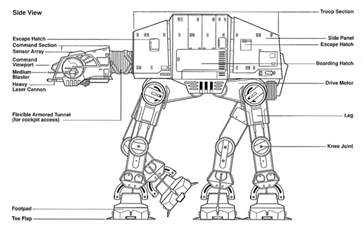Sponsor: N/A
Collaborators: N/A
Throughout the history of extraterrestrial exploration using rovers, wheels have dominated as the method of mobility. While these systems continue to have great success, research has been ongoing to develop more and more advance terrestrial robots that use walking locomotion. A walker has some advantages over their wheeled counterparts, the biggest of which is the capability to traverse extreme terrain. When applied to extraterrestrial rovers, this offers the possibility of reaching areas that no rovers previously could.
 While some walking gate robots have employed pneumatics, the compressibility of the gas and stiction in the cylinders can cause undesirable affects in the motion. Often, motors are instead used to actuate joints to provide a smoother and more well-defined motion. However, an advantage of pneumatics is a large dynamic range, providing the ability to generate both slow, methodical motion as well as rapid, energetic response, such as during a running gate. This type of flexibility could greatly extend the utility of future extraterrestrial rovers by allowing to both slowly traverse rocky, unpredictable terrain and quickly cross long stretches of flatter terrain.
While some walking gate robots have employed pneumatics, the compressibility of the gas and stiction in the cylinders can cause undesirable affects in the motion. Often, motors are instead used to actuate joints to provide a smoother and more well-defined motion. However, an advantage of pneumatics is a large dynamic range, providing the ability to generate both slow, methodical motion as well as rapid, energetic response, such as during a running gate. This type of flexibility could greatly extend the utility of future extraterrestrial rovers by allowing to both slowly traverse rocky, unpredictable terrain and quickly cross long stretches of flatter terrain.
The current objective of this project is to investigate the kinematics and controls involved in creating a two degree of freedom, pneumatically actuated walker leg, and generate a controlled, stable movement that would support the variable fore profile encountered during forward motion. Once achieved, six such legs will be built and integrated into a six-legged rover to test a variety of achievable gates.